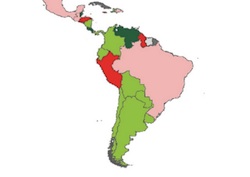The results of the 2014 LAPOP survey show that perceptions of insecurity are on the rise in Latin America, particularly in South America where a new drug trafficking dynamic may be partly to blame.
According to the 2014 Latin American Public Opinion Project (LAPOP) report, which compiles the results of surveys conducted on citizen security in the Americas, the average perception of insecurity in the region increased from 37.6 on a 100-point scale in 2012 to 43.2 in 2014. Similarly, the percentage of respondents citing security as the most important problem facing their country rose slightly over the same period, from 30.1 to 32.5 percent.
The increase was especially notable in South America (see graph below), particularly in Brazil, Bolivia, Peru, Colombia, Paraguay and Venezuela where the average perception of insecurity rose by at least 8 points. Venezuela saw the greatest change between 2012 and 2014, with a 15.6 point spike in perceived insecurity.
In Central America and the Caribbean, the countries with the greatest increases in perceived insecurity were Panama, Costa Rica and the Dominican Republic, which saw increases of between 9 and 12 points. Only respondents in Ecuador, Jamaica, Trinidad & Tobago, and Haiti reported lower levels of perceived insecurity than in 2012.
Although security perceptions changed over time, the average percentage of respondents who reported having been the victim of a crime in the last 12 months remained relatively constant. Between 2004 and 2014, the percentage of victims hovered around 17 percent, with the exception of a small spike in 2010. Peru, Ecuador, Argentina and Venezuela had the highest percentage of crime victims in 2014, according to the survey, while Jamaica, Guyana, and Panama had the lowest.
Interestingly, perceptions of security did not always correlate with the percentage of respondents who reported being victims of a crime (see graph below). In Trinidad & Tobago, for example, over two-thirds of respondents ranked security as the most important problem in their country, but less than 10 percent had been the victim of a crime in the past 12 months.
On a regional level, 56.1 percent of respondents said their neighborhoods were affected by gangs either a little, somewhat, or a lot, with Panama and Venezuela registering the highest numbers in terms of perceptions of gang activity. In Brazil, Costa Rica, the Dominican Republic and Argentina, more than half of all respondents had witnessed or heard of illegal drug sales in their neighborhoods.
InSight Crime Analysis
Increasing perceptions of insecurity in South America could be partly attributable to a new drug trafficking dynamic in the region. Whereas drug trafficking routes traditionally pointed north to the United States, growing domestic markets in some South American countries and high cocaine prices in Europe and Asia have spurred the development of new trafficking routes. Cocaine produced in Bolivia and Peru and marijuana grown in Paraguay now feed domestic markets in Brazil and Argentina, which also serve as transit points for trans-Atlantic cocaine shipments.
As a result, transnational criminal organizations have established a presence in these countries, which have also seen the development of local criminal groups. Notably, Peru and Bolivia had among the highest perceptions of insecurity in the LAPOP survey as well as some of the largest spikes in perceptions of insecurity between 2012 and 2014. Brazil and Paraguay also saw substantial increases in perceptions of insecurity, while Peru and Argentina had among the highest percentages of crime victimization. In what is likely a reflection of their growing domestic markets, Brazil and Argentina also had among the highest percentages of respondents reporting illegal drug sales.
SEE ALSO: Venezuela News and Profiles
In Venezuela’s case, the fact that the country registered both the highest perceptions of insecurity in the region and the largest increase over the last two years is likely partly the result of widespread political unrest and an ongoing economic crisis. Both of these factors have contributed to a deteriorating security situation and high homicide rates.
Interestingly, perceptions of insecurity were lower in Honduras, Guatemala, and El Salvador, which have major gang problems and some of the highest murder rates in the world, than they were in Mexico and several South American countries.
The LAPOP report offers two possible explanations for this phenomenon. Firstly, United Nations Office on Drugs and Crime (UNODC) statistics show that while homicide rates are higher in these countries, levels of assault, robbery, and sexual assault are higher in South America. Secondly, researchers have found that individuals can become desensitized to pervasive security threats and therefore report lower perceptions of insecurity than individuals in countries unaccustomed to high levels of crime and violence.
SEE ALSO: Coverage of Costa Rica
Costa Rica is likely one example of this phenomenon. Although Costa Rica has traditionally been safer than its neighbors, the country appears to be playing a growing role in the drug trade. This could be one factor driving both high perceptions of insecurity in the country and a large increase in these perceptions between 2012 and 2014.

